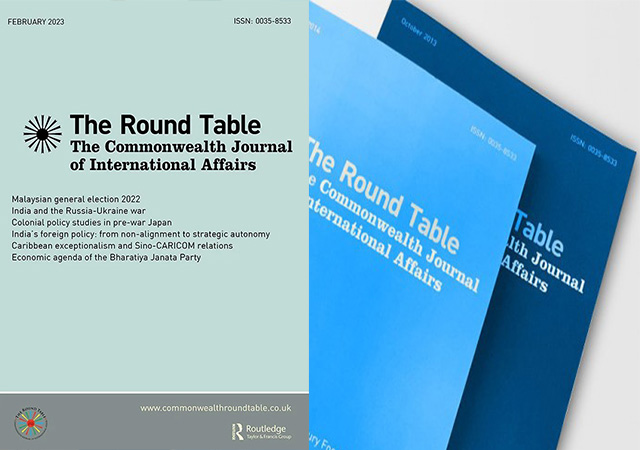
[This is an excerpt from an article in The Round Table: The Commonwealth Journal of International Affairs.]
As a newly emerging colonial power on the way to modern statehood from the late 19th century onwards, Japanese political, military, and intellectual elites sought a model (or models) among European great powers which had already accumulated substantial colonial and semi-colonial possessions. In later years, Mao Zedong famously described his country’s status as a ‘semi-colony’, as a result of the encroachment by both Western and Japanese imperial powers. According to Bayly (Citation2004), modernity ‘is an aspiration to be “up with the times”. It was a process of emulation and borrowing’. Not only political institutions such as the Meiji Constitution and the Imperial Diet, but also dress and bodily deportment were unified, largely following Western examples. In 1894, the Japanese government ordered its officials to come to work in Western dress, ‘asserting its place amongst modern imperial nations’ (Bayly, Citation2004, pp. 10, 12, 16). In addition, Burbank and Cooper (Citation2019) described Japan’s leaders as ‘discerning imperial borrowers, who absorbed lessons in military strategy and technology from French, German and British advisers’ (Burbank & Cooper, Citation2019, p. 92). Hirondo Tomizu was a jurist and one of the so-called ‘seven doctors’ – six out of seven were at Tokyo Imperial University – who submitted in June 1903 a written opinion that required the Japanese government to go to war against Russia, which had not withdrawn from Manchuria after the Boxer Rebellion of 1900. Tomizu wrote in September in the same year that Joseph Chamberlain, who carried out the South African War of 1899–1902 to ‘protect the colonial empire’ as Britain’s Colonial Secretary, was a model for Japan to resolve the ‘Manchurian Problem’ (Katayama, Citation2007, pp. 151, 157). Tomizu and Goto, the latter of whom saw the British East India Company as a model for the Mantetsu, were only a few examples among many Japanese elites who tried, though more or less rather crudely, to learn lessons from European imperialist powers, particularly Britain. Japan – with its national identity and political and social institutions – reconstituted itself through interaction with its colonies and emulation from Western imperial powers.
Japan and Commonwealth Africa
The colonial origins of Nehru’s foreign policy
The Evolution of Japan’s Security Role in Southeast Asia
Conclusion
Of course, there were certain differences between British and Japanese imperial policies and administrations. For instance, Wakimura (Citation2002) argued that imperial medicine of British India was non-interventionist (mainly because of its separationist and indirect colonial policy), while the Japanese authority adopted much more assimilationist and therefore interventionist policy in colonial Taiwan (Wakimura, Citation2002, Chapter 8). Lord Curzon’s graphic but detached description of Srinagar would tell about certain British attitudes towards India:
He sees that shining expanse of the Wular Lake lying at the base of the hills that conceal the zigzags of the Gilgit road. Into it on the one side flow the sluggish coils of the Jhelum river, brown with the dirt and drainage of Srinagar. … Srinagar was essentially tumbledown, slatternly, ignoble, unregenerate. It had in it nothing of the grandiose, or even imposing. Its colour was a uniform and dirty drab; its picturesqueness was that of decrepitude; its romance, if any, was that of decay (Curzon, Citation1984, pp. 152–153).
As Christopher (Citation1988), a South African historical geographer, pointed out, British colonial policy in general ‘sought to have as little as possible to do with indigenous populations. The British Empire was not an integrationist society. It was exclusive’ (Christopher, Citation1988, p. 22). For example, after Joseph Chamberlain became Colonial Secretary in 1895, he instructed colonial governors to separate every newly constructed building from indigenous areas, in order to insulate European populations from indigenous peoples infected by malaria (Takuma, Citation2020, p. 28). In contrast, Iijima emphasised the role of Goto, who reorganised Japan’s domestic public health policy and then established the foundation of Japanese colonial rule in Taiwan. Japan’s tendencies – at least compared to the contemporary conduct of other colonial powers such as Britain – to put more emphasis on the administration of medicine and public health originated in Taiwan and spread to other parts of Japanese formal and informal empires such as the Kwantung Leased Territory, Korea, and Manchukuo (Iijima, Citation2005, pp. 340–341). The foundation of colonial studies in Taiwan and Manchuria (mainly under the aegis of the Mantetsu), and then in the Japanese metropole such as the establishment of the Professorship of Colonial Policy at Tokyo Imperial University, were strongly influenced by Goto’s ‘colonial experiences’. In addition, because the first holder of the chair at Tokyo Imperial University, Nitobe, was originally educated and gave lectures at Sapporo Agricultural College and was then invited by Goto to supervise the industrialisation of sugar production in Taiwan, public health and agricultural administration could be considered as central to the early development of colonial policy studies in pre-war Japan. Although ‘colonial experiences’ of certain figures like Curzon, Davids, and Curtis also influenced the establishment of colonial studies in Britain, this forms a marked contrast with the early development of studies of colonial and imperial history in Britain, where mining magnates in Southern Africa and scholarly interests in contemporary imperial politics played a more important role.
Hiroyuki Ogawa is Professor, Graduate School of Arts and Sciences, University of Tokyo, Tokyo, Japan.



